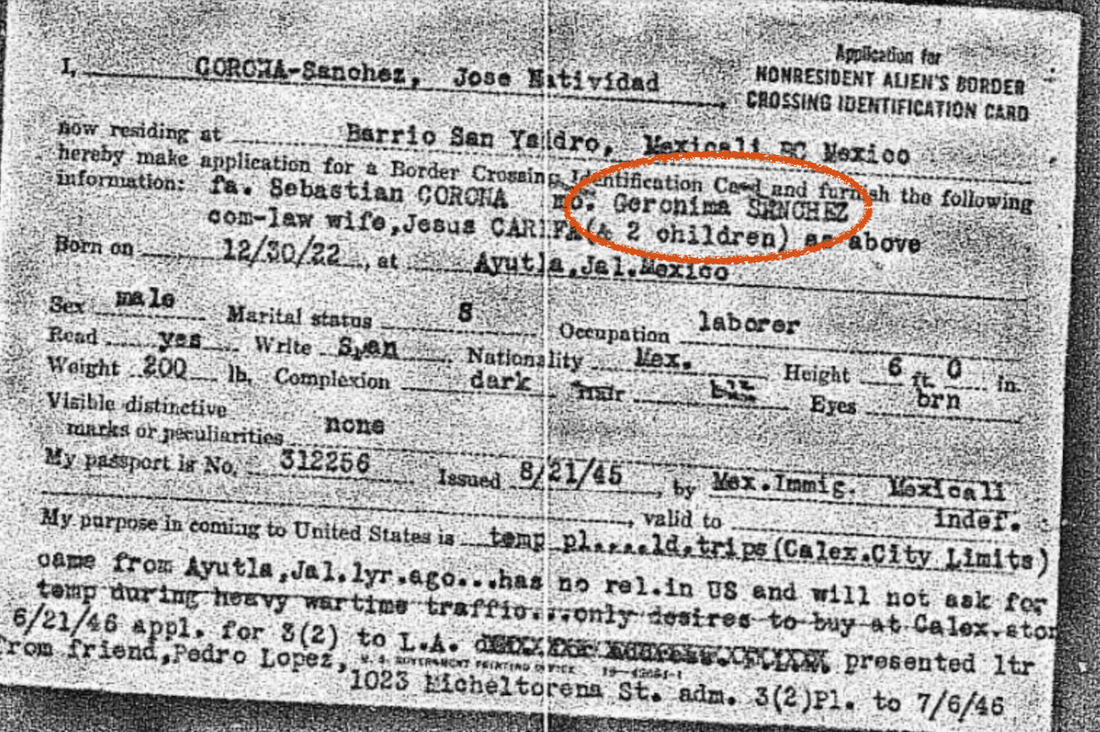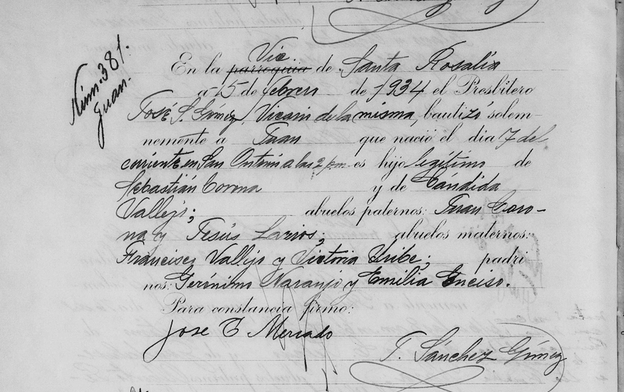|
My search for Juan Corona began with the statement that he was a 'primo' or cousin to the Medina family, which became the ultimate research question: is this man truly related to my husband? Or was this simply an erroneous assumption, based on family lore? Let's get to the answer. Follow the brother (and the father and the mother and aunt...) An important technique in genealogical research is to expand the scope to multiple family members - beyond those of interest. Records of brothers, sisters, aunts, and uncles can reveal critical insights into the lives of direct ancestors. Indeed, a full picture of each family member enriches the stories of all. This proved to be the case in my search for Juan Corona. The Corona family entry in the 1930 Mexico National Census suggests that Natividad and Juan were half-brothers. With confirmation that Cándida Uribe was the mother of Juan, and the implausibility that she was the mother of Natividad (due to their proximity in age), the next step was to identify Natividad's mother and perhaps find a clue to the relationship to the Medina family. The breakthrough For Mexican research, I rely heavily on the FamilySearch database, filled with hundreds of millions of records from the Catholic Church and the Regístro Civil - some indexed and others not. Using the search tools available for the indexed records, I looked for more information about Sebastian Corona and his first marriage (children, marriage record, etc.). No luck. There simply were no indexed records in FamilySearch matching this family. I then began the old-fashioned (and incredibly time-consuming) process of searching the unindexed Civil Registration records page-by-page. The problem with this approach was that I was using erroneous information discovered in books written about Juan Corona. Nearly all references I consulted (which largely included research conducted by lawyers, and not genealogists) suggested that the family was from Autlán. Incorrect. It appeared I had hit a brick wall. And then, using the Ancestry.com database of Mexico to U.S. Border Crossings, I located a record for Natividad. It proved to be the wrecking ball that busted through my brick wall. Within this one document is Natividad's date and place of birth, the name of his wife, a photo, and...the name of his mother! This piece of information was the key to unlocking the connection to the Medina family. Using this new information (and, in October, the release of Ancestry.com's collection of indexed Mexican Civil Registration records), I quickly discovered the rest of the story. Natividad Corona was born on December 30th, 1922, as indicated on the border crossing document. This was supported by the civil registration of his birth. Interestingly, he is listed as 'hijo ilegítimo' which would explain the reason for no marriage records for Sebastian and Gerónima. He died in Guadalajara in 1973 (following the storyline of most investigators in the U.S. that he fled to Mexico during his brother's trial). Gerónima! The next and final step to answering the research question was to build the family tree of Gerónima Sanchez. It didn't take long to tie into a tree I had long researched. My husband's great grandmother was Francisca Sanchez Ramos. The first record I discovered, though tragic, connected Gerónima to Sebastian Corona and to Francisca Sanchez. It was a 1927 death record for Señora Gerónima Sanchez, in which the informant was Sebastian Corona, and the parents were listed as Pascual y Basilia Ramos. Pascual and Basilia were Francisca's parents, as well. Natividad Corona's mother, Gerónima, was my husband's great grandmother's sister. Put another way, Natividad (Juan's half-brother) was my husband's grandfather's cousin. Ultimately, this confirmed that Juan Corona and my husband are not related. Unfortunately, it never quite resolved the question as to whether or not I married an axe murderer: Natividad was also suspected of committing the crimes.
Eh. I'll take my chances. ;)
7 Comments
People are strangely fascinated by serial killers and their crimes. In fact, murder mysteries, in general have captured the attention of the masses for centuries. Perhaps it is no surprise then, that before researching the connection of Juan Corona to my husband's family, I immediately began to scour newspapers and libraries for information about the ghastly crimes that he committed. What does history tell us? One look on Wikipedia will tell you that Juan Corona was convicted of murdering 25 migrant farm workers in 1973. He was sentenced to life in prison, and continues to serve that sentence today in Soledad, California. Keep searching, and you will find that the murders were gruesome, allegedly carried out with a machete. However, 'history' takes many forms on the internet, and much of it is fiction. Only through consulting well-documented research will you find an accurate depiction of the crimes, including the evidence used at trial. Twenty-five Murders (and probably more): Looking for a Reason, a book by John B. Dickson, includes an in-depth review of the two trials (there was an appeal following the first conviction) and the circumstances surrounding the case.
Cousin Juan Corona The Medina family remembers Juan Corona as the brother of their 'cousin' Natividad Corona. While they spent years of their youth with Natividad, they knew very little of Juan. With no recollection of exactly how they are related, my husband's aunts and uncles do know that Natividad was called 'cousin' by their father, Jose Jesus Medina, and was a 'padrino' to one of them. The term, 'cousin,' of course, does not make for an easy starting place in genealogical research. I meet a 'cousin' at nearly every genealogy conference I attend. However, it's not an impossible place to begin - they knew each other and lived in the same small town near Guadalajara. So, I began by building the family tree of Juan Corona. Juan Corona was born on February 7, 1934 in Ayutla, Jalisco, Mexico to parents Sebastian Corona Larios and Cándida Vallejo Uribe. Through my research, I located not only the baptismal record for Juan, but for several of his brothers and sisters, as well. While I was unable to locate the border-crossing documents that would indicate when he traveled to the United States, several biographies of his life suggest that he was living in the Sacramento region by the 1950s. Based on this initial two-generation tree, there is no relation to the Medina family. So, I continued with Natividad. Though his tree is the same, I had hoped I would find something among his documents that would fill in the gaps. Natividad, the brother
The search for Natividad's birth records was a challenge. I used multiple databases, and various versions of his parents' names. Though I did uncover a 1930 Mexico census that listed an approximate age (as well as other siblings), a census does not confirm the exact birth date. ...And then I saw it. Guadalupe and Natividad were 12 and 10, respectively in 1930. The father, Sebastian, was 40. The mother, Cándida, was 22. Now, there are young mothers, of course. But, this is not what occurred here. She would have been 10 years old at the birth of her first child. No, this must be a second marriage for Sebastian. Perhaps the mother of Natividad and Guadalupe would reveal the connection to the Medina family? Alright, so the title of this post carries just a tinge of hyperbole. But, I won't deny that these words did float across my mind as I heard my husband's aunt relate the tale of "Uncle Natividad" and his brother Juan, El Asesino del Machete. (Go ahead. Google him. But, don't get too excited. We'll come back to him a bit later.) Let's begin at the beginning. My husband was born and raised in Guadalajara, Jalisco - a beautiful city with Spanish architecture, legendary music, and equally legendary food. His parents' families are from small, rural towns on the periphery of the big city. I've been fortunate to not only hear stories of these romantic Mexican villages, but to visit them, as well. My family hails from north of the border. On my father's side, after living for generations in Oklahoma, they traveled west and landed in Marysville, California, a small agricultural town near the state capital of Sacramento. (Rural, yes. Romantic, not so much.) Our heritage could not be farther apart - in distance and in culture. And, if you had asked me 3 months ago if it were possible that our families crossed paths over 60 years ago, I would have dismissed the idea as statistically silly and basically impossible. The world is simply not that small. And I would have been wrong. From Guadalajara, Jalisco to Marysville, California During a recent visit to Guadalajara, my husband's aunt shared a few stories from her experience working in the U.S. I had always known that she spent time working in Chicago, so when I heard her mention taking a bus to her destination, I had to inquire: "you traveled by bus from San Diego to Chicago?!" Her response was quick: "Yes, but not on that trip." This time, she was referring to her first venture to the U.S. as a very young woman, to work with her father's relative, Natividad Corona. In Marysville, California. I nearly fell out of my chair. Marysville? Near Sacramento? A town with a population of only 7,800 in 1950? The same town that my grandfather lived and worked in for many years?! The answer to all of those questions, of course, was yes. It was the very same place. And who would have guessed it? My husband's aunt and my grandfather were in the same small town, at the same time. Incredible. But the story did not end there. This stay in the U.S was with Natividad Corona. And there was so much more to tell about Natividad and his notorious brother, Juan. According to the family, these brothers were cousins (2nd or 3rd?) to my husband's grandfather - though, no one was able to define the exact relationship. Natividad traveled to California in the 1940s and after working in agriculture for some time, became a labor contractor for migrant farm workers in the region. While staying with Natividad, my husband's aunt's job was to cook and serve three meals a day to the farm workers - 90 of them, three times a day. She also worked with Juan, Natividad's younger brother. As she recalled the difficulties of this work, she mentioned the scandal and "horror" of Juan's acts, which occurred years after she had returned to Mexico. There seemed to be an assumption that I was aware of these events and the connection to the family. But, I was in the dark - and my interest was piqued. Who was Juan Corona, and what, pray tell, did he do?! Then, she showed me a small booklet she had saved from the year it happened. A search for the truthThus began a 3-month search for Juan Corona. I was intensely curious about the crimes. I wondered whether he was guilty. I wondered if he were still alive. And, perhaps most importantly, I was determined to prove (or disprove) the family connection between my husband and this mysterious, alleged murderer.
|
AuthorLisa Medina, here to share the history of families - one story at a time. . Archives
May 2016
Categories
All
Copyright © 2020-2021 Lisa Medina Genealogist & Family Historian
|












 RSS Feed
RSS Feed
